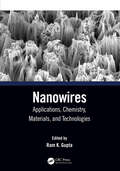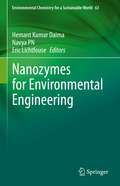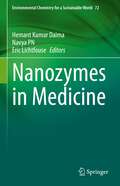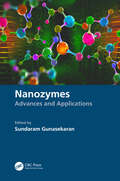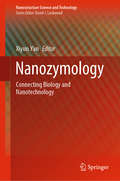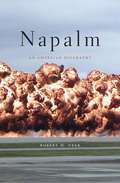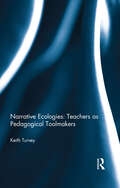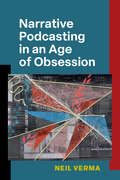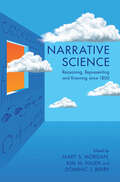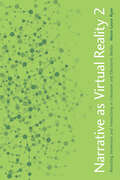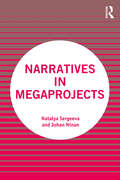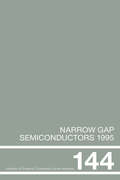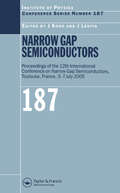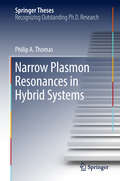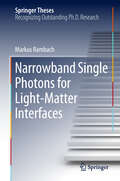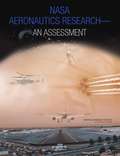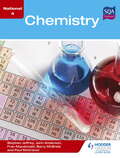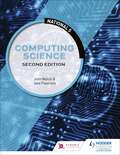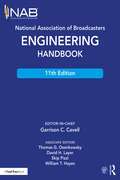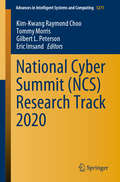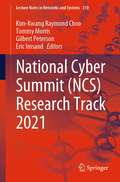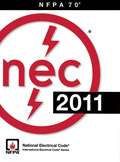- Table View
- List View
Nanowires
by Anqi Zhang Gengfeng Zheng Charles M. LieberThis book provides a comprehensive summary of nanowire research in the past decade, from the nanowire synthesis, characterization, assembly, to the device applications. In particular, the developments of complex/modulated nanowire structures, the assembly of hierarchical nanowire arrays, and the applications in the fields of nanoelectronics, nanophotonics, quantum devices, nano-enabled energy, and nano-bio interfaces, are focused. Moreover, novel nanowire building blocks for the future/emerging nanoscience and nanotechnology are also discussed. Semiconducting nanowires represent one of the most interesting research directions in nanoscience and nanotechnology, with capabilities of realizing structural and functional complexity through rational design and synthesis. The exquisite control of chemical composition, morphology, structure, doping and assembly, as well as incorporation with other materials, offer a variety of nanoscale building blocks with unique properties.
Nanowires: Applications, Chemistry, Materials, and Technologies
by Ram K. GuptaThis comprehensive resource covers the fundamentals of synthesis, characterizations, recent progress, and applications of nanowires for many emerging applications. Early chapters address their unique properties and morphology that enable their electronic, optical, and mechanical properties to be tuned. Later chapters address future perspectives and future challenges in areas where nanowires could provide possible solutions. All chapters are written by global experts, making this a suitable textbook for students and an up-to-date handbook for researchers and industry professionals working in physics, chemistry, materials, energy, biomedical, and nanotechnology. Covers materials, chemistry, and technologies for nanowires. Covers the state-of-the-art progress and challenges in nanowires. Provides fundamentals of the electrochemical behavior of various electrochemical devices and sensors. Offers insights on tuning the properties of nanowires for many emerging applications. Provides a new direction and understanding to scientists, researchers, and students.
Nanozymes for Environmental Engineering (Environmental Chemistry for a Sustainable World #63)
by Eric Lichtfouse Hemant Kumar Daima Navya PnThis book reviews the latest developments and applications of nanozymes in environmental science. Protection of the environment is essential because pollution has become a global problem with many adverse effects on life and ecosystems. For that, remediation strategies and techniques have been designed, yet they are limited. Here, the recent development of nanotechnology opens a new vista for environmental remediation. In particular, nanomaterials displaying enzyme-like activities, named ‘nanozymes’, appear very promising for environmental monitoring, contaminant detection, microbial management, and degradation of organic pollutants. Nanomaterials including metallic, metal oxides and carbon-based nanoparticles with nanozymes activities have been synthesized. These nanozymes have similar activities as natural peroxidase, oxidase, superoxide dismutase and catalase enzymes. Nanozymes have several advantages, yet they suffer from several limitations such as low catalytic efficiency, less substrate selectivity, biocompatibility, and lack of engineering of the active sites.
Nanozymes in Medicine (Environmental Chemistry for a Sustainable World #72)
by Eric Lichtfouse Hemant Kumar Daima Navya PnThis book reviews the latest advances and biomedical applications of nanozymes, which are artificial nanomaterials exhibiting enzymatic properties similar to natural enzymes, but with less limitations than natural enzymes. Nanozymes display advantages such as facile synthesis, easy surface modification, improved stability, higher catalytic power, and target-specific binding. Nanozymes containing metals, metal oxides, carbon, and metal sulfide are actually used for cancer therapy, biomolecules sensing, bioimaging, disease diagnostics and diabetes management. The book discloses underlying mechanisms, concepts, recent trends, constraints, and prospects for nanomedicine using nanozymes.
Nanozymes: Advances and Applications
by Sundaram GunasekaranThis book presents the state-of-the-art advances and applications of nanozymes, the recently developing branch of enzymology that synthesizes and uses nanomaterials that mimic the function of traditional enzymes. During the past decade, the study of nanozymes has grown rapidly. Several new nanomaterials that exhibit enzymatic actions have been identified, along with new applications for their practical use. This book draws upon the work of experts from around the world and provides an in-depth analysis and cutting-edge overview of nanozymes, with an eye toward their present and future applications. Chapters are arranged in a logical order to provide physio-chemical characterization of nanozyme and basic mechanisms of their enzymatic actions. Focusing on current limitations of nanozymes and their reaction kinetics, the book presents a comprehensive discourse on nanozyme engineering that includes possible surface modifications to enhance nanozyme effectiveness. It also focuses on traditional and novel nanozyme applications, such as biosensing, drug delivery, and disease therapy, as well as their use as antibacterials. An important addition in this book is the summary of emerging literature on nanozyme toxicology. This book is intended as a ready reference for advanced undergraduate and graduate students doing research in nanotechnology; materials science; chemistry; and chemical, biological, biomedical, and food engineering. Research and development scientists, engineers, and technologists working in the chemical and biological/biomedical industries will gain much from the materials in this book for their industry practice. Presents a comprehensive discourse on nanozyme engineering that includes possible surface modifications to enhance nanozyme effectiveness. Discusses metal organic frameworks as nanozymes. Reviews on traditional and novel nanozyme applications, such as biosensing, drug delivery, disease therapy, and their use as antibacterials. Examines nanozyme toxicology. Dr. Sundaram Gunasekaran is a Professor in the Department of Biological Systems Engineering at the University of Wisconsin–Madison.
Nanozymology: Connecting Biology and Nanotechnology (Nanostructure Science and Technology)
by Xiyun YanThis book introduces the new concept of “nanozyme”, which refers to nanomaterials with intrinsic enzymatic activity, rather than nanomaterials with biological enzymes incorporated on the surface. The book presents the cutting-edge advances in nanozyme, with emphasis on state-of-the-art applications in many important fields, such as in the biomedical fields and for environmental protection. The nanozyme is a totally new type of artificial enzyme and exhibits huge advantages over natural enzymes, including greater stability, low cost, versatility, simplicity, and suitability for industry. It is of interest to university researchers, R&D engineers, as well as graduate students in nanoscience and technology, and biology wishing to learn the core principles, methods, and the corresponding applications of “nanozyme”.
Nantgarw and Swansea Porcelains: A Forensic Re-evaluation
by Howell G.M. EdwardsThis book gives a detailed account of the holistic research carried out on the analytical data obtained historically on the products of the Nantgarw and Swansea porcelain manufactories which existed for a few years only during the second decade of the 19th Century. A background to the establishment of the two factories, which are linked through the persons of the enigmatic William Billingsley and his kiln manager, Samuel Walker, involves the sourcing of their raw materials and problems associated with the manufacture and distribution of the finished products. A description of the minerals and additives used in porcelain production is recounted to set the scene for the critical evaluation of the comprehensive analytical data which have been published on Nantgarw and Swansea porcelains. For the first time, the author has adopted a nondestructive technique, Raman spectroscopy, to interrogate perfect samples of Nantgarw and Swansea porcelain, as well as a selection of shards from an archaeological excavation carried out at a waste dump at the Nantgarw China Works site. Following these experiments, several questions relating to the porcelain bodies of Swansea and Nantgarw china can be answered and a protocol established for the preliminary evaluation of items of suspect attribution to confirm or not the correctness of their assignment to these Welsh porcelain factories.
Napalm: An American Biography
by Robert M. NeerNapalm, incendiary gel that sticks to skin and burns to the bone, came into the world on Valentine's Day 1942 at a secret Harvard war research laboratory. On March 9, 1945, it created an inferno that killed over 87,500 people in Tokyo-more than died in the atomic explosions at Hiroshima or Nagasaki. It went on to incinerate sixty-four of Japan's largest cities. The Bomb got the press, but napalm did the work. After World War II, the incendiary held the line against communism in Greece and Korea-Napalm Day led the 1950 counter-attack from Inchon-and fought elsewhere under many flags. Americans generally applauded, until the Vietnam War. Today, napalm lives on as a pariah: a symbol of American cruelty and the misguided use of power, according to anti-war protesters in the 1960s and popular culture from Apocalypse Now to the punk band Napalm Death and British street artist Banksy. Its use by Serbia in 1994 and by the United States in Iraq in 2003 drew condemnation. United Nations delegates judged deployment against concentrations of civilians a war crime in 1980. After thirty-one years, America joined the global consensus, in 2011. Robert Neer has written the first history of napalm, from its inaugural test on the Harvard College soccer field, to a Marine Corps plan to attack Japan with millions of bats armed with tiny napalm time bombs, to the reflections of Phan Thi Kim Phuc, a girl who knew firsthand about its power and its morality.
Narrative Ecologies: Teachers As Pedagogical Toolmakers
by Keith TurveyIn recent years there has been significant investment by policy makers in the potential of technological tools to transform learning and teaching across a range of professional practitioner groups; education, nursing and social care. There remain, however, outstanding issues concerning the ways educators and professional practitioners harness the p
Narrative Podcasting in an Age of Obsession
by Neil VermaIt has been a decade since Serial brought the narrative podcast to the center of popular culture. In that time, there has been an enormous boom in the production of podcasts that tell stories, particularly in the fields of true crime, storytelling, history, and narrative fiction. Now that the initial glow around the medium has begun to fade, it is time to reevaluate the medium’s technological, political, economic, and cultural rise, in particular what types of storytelling accompanied that rise. Narrative Podcasting in an Age of Obsession is the first book to look back on this prodigious body of material and attempt to make sense of it from a structural, historical, and analytic point of view. Focusing on more than 350 podcasts and other audio works released between Serial and the COVID pandemic, the book explores why so many of these podcasts seem “obsessed with obsession,” why they focus not only on informing listeners but also dramatizing the labor that goes into it, and why fiction podcasts work so hard to prove they are a brand new form, even as they revive features of radio from decades gone by. This work also examines the industry's reckoning with its own implication in systemic racism, misogyny, and other forms of discrimination. Employing innovative new critical techniques for close listening—including pitch tracking software and spectrograms—Narrative Podcasting in an Age of Obsession makes a major contribution to podcast studies and media studies more broadly.
Narrative Science: Reasoning, Representing and Knowing since 1800
by Mary S. Morgan Kim M. Hajek Dominic J. BerryNarrative Science examines the use of narrative in scientific research over the last two centuries. It brings together an international group of scholars who have engaged in intense collaboration to find and develop crucial cases of narrative in science. Motivated and coordinated by the Narrative Science project, funded by the European Research Council, this volume offers integrated and insightful essays examining cases that run the gamut from geology to psychology, chemistry, physics, botany, mathematics, epidemiology, and biological engineering. Taking in shipwrecks, human evolution, military intelligence, and mass extinctions, this landmark study revises our understanding of what science is, and the roles of narrative in scientists' work. This title is also available as Open Access.
Narrative as Virtual Reality 2: Revisiting Immersion and Interactivity in Literature and Electronic Media
by Marie-Laure RyanRethinking textuality, mimesis, and the cognitive processing of texts in light of new modes of artistic world construction.Winner of the Aldo and Jeanne Scaglione Prize for Comparative Literary Studies from the Modern Language Association of AmericaIs there a significant difference between engagement with a game and engagement with a movie or novel? Can interactivity contribute to immersion, or is there a trade-off between the immersive "world" aspect of texts and their interactive "game" dimension? As Marie-Laure Ryan demonstrates in Narrative as Virtual Reality 2, the questions raised by the new interactive technologies have their precursors and echoes in pre-electronic literary and artistic traditions. Approaching the idea of virtual reality as a metaphor for total art, Ryan applies the concepts of immersion and interactivity to develop a phenomenology of narrative experience that encompasses reading, watching, and playing. The book weighs traditional literary narratives against the new textual genres made possible by the electronic revolution of the past thirty years, including hypertext, electronic poetry, interactive drama, digital installation art, computer games, and multi-user online worlds like Second Life and World of Warcraft.In this completely revised edition, Ryan reflects on the developments that have taken place over the past fifteen years in terms of both theory and practice and focuses on the increase of narrativity in video games and its corresponding loss in experimental digital literature. Following the cognitive approaches that have rehabilitated immersion as the product of fundamental processes of world-construction and mental simulation, she details the many forms that interactivity has taken—or hopes to take—in digital texts, from determining the presentation of signs to affecting the level of story.
Narratives in Megaprojects
by Natalya Sergeeva Johan NinanThis book is a novel contribution to a field dominated by conventional approaches to project management; it is about narratives in megaprojects. Among the questions examined in this original new book are: • What are narratives? • Why are they important in megaprojects? • How are they formed and used in megaprojects? • How do promotors of and protestors against megaprojects craft narratives to their advantage? • What strategies can project managers employ to effectively use narratives in megaprojects? Built from longitudinal research studies in combination with internationally recognised teaching materials, this book will provide readers with a theoretical understanding of narratives and projects, as well as practical international case studies, including HS2, the Dakota Access Pipeline, the Eden Project and Thames Tideway, to support their understanding. The authors explain the different types of narrative, and how and why they are important in general and in relation to a megaproject and its lifecycle, but also explore how to craft narratives in different situations, and how they are changed and maintained over a project's lifecycle. Narratives in Megaprojects doubles as a text supporting more advanced courses on project management or aspects thereof, and as a reflection of the state of the art in this particular perspective on megaprojects. It is essential reading for all students and professionals in project management, construction and infrastructure as well as executive leaders involved in megaprojects and infrastructure delivery.
Narrow Gap Semiconductors 1995: Proceedings of the Seventh International Conference on Narrow Gap Semiconductors, Santa Fe, New Mexico, 8-12 January 1995 (Institute Of Physics Conference Ser. #144)
by J L RenoNarrow Gap Semiconductors 1995 contains the invited and contributed papers presented at the Seventh International Conference on Narrow Gap Semiconductors, held in January 1995. The invited review papers provide an overview and the contributed papers provide in-depth coverage of research results across the whole field.
Narrow Gap Semiconductors: Proceedings of the 12th International Conference on Narrow Gap Semiconductors (Institute of Physics Conference Series)
by J Kono J LéotinThis volume forms a solid presentation in several important areas of NGS research, including materials, growth and characterization, fundamental physical phenomena, and devices and applications. It examines the novel material of InAs and its related alloys, heterostructures, and nanostructures as well as more traditional NGS materials such as InSb, PbTe, and HgCdTe. Several chapters cover carbon nanotubes and spintronics, along with spin-orbit coupling, nonparabolicity, and large g-factors. The book also deals with the physics and applications of low-energy phenomena at the infrared and terahertz ranges.
Narrow Plasmon Resonances in Hybrid Systems
by Philip A. ThomasAdvances in understanding the interactions between light and subwavelength materials have enabled the author and his collaborators to tailor unique optical responses at the nanoscale. In particular, metallic nanostructures capable of supporting surface plasmons can be designed to possess spectrally narrow plasmon resonances, which are of particular interest due to their exceptional sensitivity to their local environment. In turn, combining plasmonic nanostructures with other materials in hybrid systems allows this sensitivity to be exploited in a broad range of applications. In this book the author explores two different approaches to attaining narrow plasmon resonances: in gold nanoparticle arrays by utilising diffraction coupling, and in copper thin films covered by a protective graphene layer. The performance of these resonances is then considered in a number of applications. Nanoparticle arrays are used along with an atomic heterostructure as elements in a nanomechanical electro-optical modulator that is capable of strong, broadband modulation. Strong coupling between diffraction-coupled plasmon resonances and a gold nanoparticle array and guided modes in a dielectric slab is used to construct a hybrid waveguide. Lastly, the extreme phase sensitivity of graphene-protected copper is used to detect trace quantities of small toxins in solution far below the detection limit of commercial surface plasmon resonance sensors.
Narrowband Single Photons for Light-Matter Interfaces (Springer Theses)
by Markus RambachThis book provides a step-by-step guide on how to construct a narrowband single photon source for the integration with atom-based memory systems. It combines the necessary theoretical background with crucial experimental methods and characterisations to form a complete handbook for readers at all academic levels. The future implementation of large quantum networks will require the hybridisation of photonic qubits for communication with quantum memories in the context of information storage. Such an interface requires carefully tailored single photons to ensure compatibility with the chosen memory. The source itself is remarkable for a number of reasons, including being the spectrally narrowest and brightest source of its kind; in addition, it offers a novel technique for frequency stabilisation in an optical cavity, together with exceptional portability. Starting with a thorough analysis of the current literature, this book derives the essential parameters needed to design the source, describes its individual components in detail, and closes with the characterisation of a single photon source.
Nasa Aeronautics Research--an Assessment
by National Research Council of the National AcademiesIn 2006, the NRC published a Decadal Survey of Civil Aeronautics: Foundation for the Future, which set out six strategic objectives for the next decade of civil aeronautics research and technology. To determine how NASA is implementing the decadal survey, Congress mandated in the National Aeronautics and Space Administration Act of 2005 that the NRC carry out a review of those efforts. Among other things, this report presents an assessment of how well NASA’s research portfolio is addressing the recommendations and high priority R&T challenges identified in the Decadal Survey; how well NASA’s aeronautic research portfolio is addressing the aeronautics research requirements; and whether the nation will have the skilled workforce and research facilities to meet the first two items.
National 4 Chemistry
by John Anderson Fran Macdonald Stephen Jeffrey Barry McBride Paul McCranorExam Board: SQALevel: National 4Subject: ScienceFirst Teaching: September 2013First Exam: June 2014This book is a comprehensive resource for pupils studying National 4 Chemistry which adheres closely to the SQA syllabus. Each section of the book matches a mandatory unit of the syllabus, and each chapter corresponds to a key area. In addition to the core text, the book contains a variety of special features:· Activities to consolidate learning and help in preparing for the Added Value Unit· Worked examples to demonstrate key processes· In-text questions to test knowledge and understanding· End-of-chapter questions for homework and assessment· Summaries of key facts and concepts· Answer section at the back of the book
National 5 Computing Science, Second Edition
by John Walsh Jane PatersonExam Board: SQALevel: National 5 Subject: Computing ScienceFirst Teaching: August 2017First Exam: June 2018National 5 Computing Science provides complete coverage of the new SQA syllabus for the updated National 5 course Ensures clear support throughout the course with a text built specifically around the requirements, teaching approaches and syllabus outlines. Divided into four sections to follow this latest syllabus: Software Design and Development, Computer Systems, Database Design and Development and Web Design and Development.Assesses student progress with regular questions for National 5 students to test knowledge and understandingConsolidates knowledge with a summary of key points at the end of each chapterIncludes a glossary and index for ease of reference
National 5 Computing Science: Second Edition
by John Walsh Jane PatersonExam Board: SQALevel: National 5 Subject: Computing ScienceFirst Teaching: August 2017First Exam: June 2018National 5 Computing Science provides complete coverage of the new SQA syllabus for the updated National 5 course Ensures clear support throughout the course with a text built specifically around the requirements, teaching approaches and syllabus outlines. Divided into four sections to follow this latest syllabus: Software Design and Development, Computer Systems, Database Design and Development and Web Design and Development.Assesses student progress with regular questions for National 5 students to test knowledge and understandingConsolidates knowledge with a summary of key points at the end of each chapterIncludes a glossary and index for ease of reference
National Association of Broadcasters Engineering Handbook
by Garrison C. CavellThe NAB Engineering Handbook is the definitive resource for broadcast engineers. It provides in-depth information about each aspect of the broadcast chain from audio and video contribution through an entire broadcast facility all the way to the antenna. New topics include Ultra High Definition Television, Internet Radio Interfacing and Streaming, ATSC 3.0, Digital Audio Compression Techniques, Digital Television Audio Loudness Management, and Video Format and Standards Conversion. Important updates have been made to incumbent topics such as AM, Shortwave, FM and Television Transmitting Systems, Studio Lighting, Cameras, and Principles of Acoustics. The big-picture, comprehensive nature of the NAB Engineering Handbook will appeal to all broadcast engineers—everyone from broadcast chief engineers, who need expanded knowledge of all the specialized areas they encounter in the field, to technologists in specialized fields like IT and RF who are interested in learning about unfamiliar topics. Chapters are written to be accessible and easy to understand by all levels of engineers and technicians. A wide range of related topics that engineers and technical managers need to understand are covered, including broadcast documentation, FCC practices, technical standards, security, safety, disaster planning, facility planning, project management, and engineering management.
National Cyber Summit (Advances in Intelligent Systems and Computing #1271)
by Kim-Kwang Raymond Choo Gilbert L. Peterson Tommy Morris Eric ImsandThis book presents findings from the papers accepted at the Cyber Security Education Stream and Cyber Security Technology Stream of The National Cyber Summit’s Research Track, reporting on the latest advances on topics ranging from software security to cyber attack detection and modelling to the use of machine learning in cyber security to legislation and policy to surveying of small businesses to cyber competition, and so on. Understanding the latest capabilities in cyber security ensures that users and organizations are best prepared for potential negative events. This book is of interest to cyber security researchers, educators, and practitioners, as well as students seeking to learn about cyber security.
National Cyber Summit (Lecture Notes in Networks and Systems #310)
by Kim-Kwang Raymond Choo Gilbert Peterson Tommy Morris Eric ImsandThis book presents findings from the papers accepted at the Cyber Security Education Stream and Cyber Security Technology Stream of The National Cyber Summit’s Research Track, reporting on latest advances on topics ranging from software security to cyber-attack detection and modelling to the use of machine learning in cyber security to legislation and policy to surveying of small businesses to cyber competition, and so on. Understanding the latest capabilities in cyber security ensures users and organizations are best prepared for potential negative events. This book is of interest to cyber security researchers, educators and practitioners, as well as students seeking to learn about cyber security.
National Electrical Code 2011 (NFPA #70)
by National Fire Protection Association StaffSafe, efficient, code-compliant electrical installations are made simple with the latest publication of this widely popular resource. Like its highly successful previous editions, the National Electrical Code 2011 softcover version combines solid, thorough, research-based content with the tools you need to build an in-depth understanding of the most important topics. New to the 2011 edition are articles including first-time Article 399 on Outdoor, Overhead Conductors with over 600 volts, first-time Article 694 on Small Wind Electric Systems, first-time Article 840 on Premises Powered Broadband Communications Systems, and more. The National Electrical Code is adopted in all 50 states, and is an essential reference for those in or entering careers in electrical design, installation, inspection, and safety.

